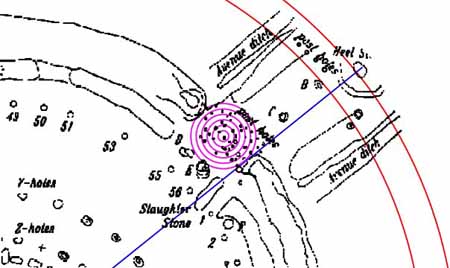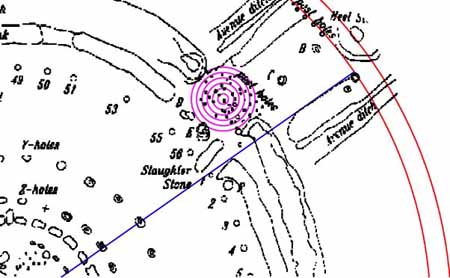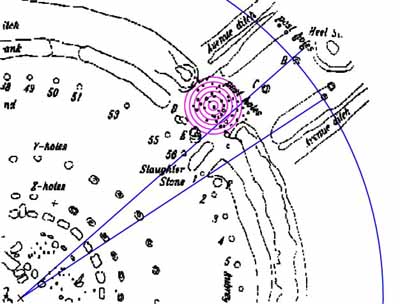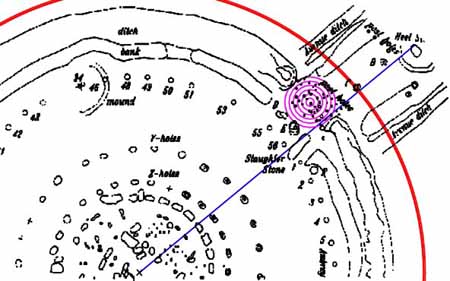In the foregoing picture a line (blue) originating at Stonehenge's centre, dissects the centre of the Heel stone. The azimuth angle of this line, off North, is 51.18333333-degrees, which equates to 51 degrees, 11 minutes. This is the official latitude designation for Stonehenge (51 deg. 11 minutes).
Note how the line relates to the Avenue set of circles (magenta) and brushes the northern side of the large post marker adjacent to the Avenue circles. A nearby line of posts extends toward the Heel Stone, as if to indicate this "latitude" line.
It is normal carpentry or surveying practice to have "sighting-lines" run to the "side" of pegs or posts, rather than to the centres, as far greater accuracy is achieved and the surveyor is able to visually verify the accuracy of the full alignment. When a line runs to the centre of a stone, the stone itself will generally have a peaked or pointed top to finitely indicate the refined intended position of the alignment.

Figure 16: Another circle of immense importance, which links Stonehenge to the Lunar codes of the Khafre Pyramid of Egypt. It will be noted that this circle (2nd inward red) brushes two component positions on the Avenue, one of which has the official designation "B". The diameter of this circle is 472.5 feet, which is exactly the intended vertical height of the Khafre Pyramid of Egypt. The base measurement of Khafre was 15/16ths that of the Great Pyramid or 708.75 feet. It was also built to a 3,4,5 triangulation code, with 1/2 the base length acting as the adjacent (354.375 feet), the vertical height acting as the opposite (472.5 feet) and the diagonal face acting as the hypotenuse (590.625 feet).
Each of these values was in deference to the lunar month and lunar year (based upon 29.53125 days per lunar month or 345.375 days per lunar year).
The diameter of this Stonehenge circle is, therefore, coding the height of the Khafre Pyramid in increments of 16 X 29.53125-days/ feet. This value of 472.5 days was also integral to the ancient method of measuring the 18.613-year lunar nutation cycle, which was calibrated to endure for 6804-days (230.4 lunar months of 29.53125-days or 14.4 time periods of 472.5-days duration). Note also that 230.4 is an expression of the very important ancient number 11.52.
For a full account related to the importance of this Stonehenge circle value, review the section dedicated to the Khafre Pyramid lunar codes.

Figure 17: Another circle and angle vector, each containing dynamic codes. The blue line, originating at site centre, is on an azimuth angle of exactly 55-degrees. Note how it brushes the earth-works features adjacent to the Slaughter Stone and then the embankment line near the Avenue ditch. The 55-number was the basis of an 11-series of numbers used in navigation. The league, mile, furlong, chain, rod/ perch, fathom & link were all included in this 11 & 55 series. The linear distance generated by these "11 & 55" increments would convert smoothly to a sexagesimal circumference, which would produce accurate degree angles toward point of departure or plotted destination.
The circle (red) has a radius of 243 feet (486 feet diameter). There were 243 X 28-days (Sabbatical Months) in the ancient 6804-day lunar nutation cycle (18.613-years). This radius or diameter number also ties Stonehenge to the Khafre Pyramid's lunar codes, as Khafre coded the 6804-day nutation cycle into its base perimeter (34020 inches...68040 ( 2). Each 5" of Khafre's base would have inferred 1 day in the 18.613-year lunar cycle.

Figure 18: This picture shows a blue circle and two vectors, originating at site centre, which brush and resolve onto Avenue component positions. The blue circle is a PHI circle (466 feet diameter...a PHI ratio increase on the diameter of the Aubrey Circle)..
The two vectors comply to degree angles of 48.6 & 56.7-degrees respectively. The 48.6-degree vector resolves to the edge of an earlier shown circle of 486 feet diameter. This number is an important "lunar" value encrypted into the Khafre Pyramid. The period of 486 days was 1/14th (septimal) of the assigned calibration (6804-days) used anciently to describe the 18.613 lunar nutation cycle. This angle (48.6-degrees) appears to align onto the "first glint" position of the summer sunrise (as seen on the north-eastern horizon, which was .6 of a degree higher than Stonehenge). The evidence would suggest that this chosen "first glint" position of the summer solstice sun was the "benchmark" surveying position upon which the site layout was conceived. The "station stones" positions appear to be mathematically configured by and locked onto a 48.6-degrees azimuth...90 degrees opposed. This will be discussed at length as we proceed.
The 56.7-degree vector was also used as a part of the numerical method for lunar determinations. It is 1/120th (sexagesimal) of the 6804-day (18.613-year) lunar cycle. The time-span of 5670 days was the ancient calibration for 16 lunar years (@ 354.375 days per lunar year). The half value for 5670 is 2835 and the Khafre Pyramid (Egypt's pyramid of the moon) had a base perimeter value of 2835 feet (708.75 feet X 4). The coding of 56.7 feet (doubled out to 113.4 feet) will arise again in a dynamic way between the "station stones" of Stonehenge (to be discussed shortly). Note also that 56.7 feet is exactly 1/8th of the height of the Great Pyramid, under its sexagesimal assignment (453.6 feet).

Figure 19: The blue vector, originating at site centre, brushes a series of posts of the Avenue "post holes" circle. It then brushes the side of a central Avenue component designated "C" before resolving onto a position at or very near to the NNE side of the Heel Stone. This vector is set to an azimuth angle of 50.4-degrees, which is an extremely important number found upon the Great Pyramid of Egypt. Trigonometry would dictate that the "flat floor" altar atop the Great Pyramid have a side length of 44-feet. Reducing PHI values from the base of the Great Pyramid would dictate that the altar worked, in part, to a value of 42-feet, which is 504 inches. The sexagesimal size of the Earth @ 3024 (the Great Pyramid's base perimeter value and 1/2 a minute of arc) X 43200 (a derivative of the Sun's radius value in miles) = the sexagesimal system's Earth size value of 130636800 feet. This number, when divided by 504 renders an expression of the Precession of the Equinoxes value of 259200. The Precession of the Equinoxes cycle endured for 25920 years.
The thickened red circle is, in fact, 4 close-proximity circles in one. These 4-circles are representative of the 4 main geodetic systems, used for world-wide navigation in ancient times and component "C" was set, specifically, in that position to code the 4 systems. It is assumed that the original component would have had slightly increased, incised marks (calibrations) across the top surface to indicate the diameter limits of each, marginally different, geodetic circle.
The centre of component "C" complies to a measurement of 207.36 feet from the centre of Stonehenge and this measurement was intended to convey THE EXACT SIZE OF THE EARTH'S EQUATORIAL CIRCUMFERENCE. Let's review how this radius value coded the size of the Earth:
1. The Great Pyramid's builders wished to encode 3 primary geodetic systems, as well as a 4th very accurate rendition of the Earth's size, into the assigned or true height value of the pyramid. The actual height was set to a PHI value of 168 Megalithic Yards or 453.049492 feet. This figure provided the basis for calculating the Earth's circumference according to a PHI geodetic system. The PHI system itself appears to be a little cumbersome, as well as the least accurate of the 3 systems for describing the Earth's true size. It's plausible to assume that the PHI method would not have been used, to any great extent, for ocean traversal and general navigation. The formula used was : 453.049492 ( 22 (1/2 the altar length) = 20.59315873 X 1200 = 24,711.79047 (read as miles). This was a shortfall on the ancient, refined equatorial size of the Earth by .006936346%. The system allowed for mathematical progressions, based upon Megalithic Yard and other PHI values, to calibrate the "ring of the Earth". Some Egyptian "Royal Cubit" rods would have been fashioned, as close as possible, to 20.59315873 inches for mnemonic reference to the "PHI rendered" size of the Earth. It is assumed that an incised calibration mark on component "C" at Stonehenge, would have been 205.9315872 feet from site centre or 2471.179047 inches (interpreted as meaning 24,711.79047 miles, 130478253.7 feet or 48384000 Megalithic Yards. The Megalithic Yard value for the Earth's size is also the PHI height of the Pyramid (168MY) X 288000.
2. A 2nd incised calibration on component "C" at Stonehenge would have marked the distance of 206.1818182 feet from site centre (2474.181818 inches). This was derived from a symbolic, sexagesimal height assignment for the Great Pyramid, set to 453.6 feet. The formula for determining this height is found by applying a 3,4,5 triangulation principle to the pyramid's true base length...756 feet ( 1.666666 = 453.6. In 3,4,5 triangulation the "adjacent" is always 1.666666 less than the "hypotenuse". The Great Pyramid height set to 453.6 feet ÷ 22 (1/2 the length of the altar) = 20.61818182 X 1200 = 24,741.81818 (read as miles). This system reduced beautifully into degrees (362880 feet...the Great Pyramid's base perimeter value was 36288 inches); minutes of arc (6804 feet...the Great Pyramid's base perimeter value was 3024 feet or 1/2 of 6804); seconds of arc (100.8 feet...the diameter of the inner Sarsen Circle at Stonehenge was set to 100.8 feet, through one sectional cross-measure, to encode 1 second of arc under the versatile sexagesimal geodetic system). Note also that an Egyptian Royal Cubit rod, at the Turin Museum, has a length of 20.618 inches... for mnemonic reference to the sexagesimal size of the Earth. This system would have been very popular for grid referencing the Earth into degrees, minutes and seconds of arc. It was, however, probably not the "most utilised" system of navigation by ancient mariners and explorers. Under this system there was a shortfall on the ancient, refined equatorial size of the Earth of .005714286%.
3. A 3rd incised calibration on component "C" at Stonehenge would have marked a distance of 206.25 feet (2475 inches) from site centre. This was based upon a symbolic height assignment for the Great Pyramid, set to 453.75 feet, which was part of an "11 series" geodetic system. Out of this system the British measurements of the league, mile, furlong, chain, rod/ perch, fathom and link were derived...at a very early epoch when Indo-European peoples lived in the environs of Egypt. Under the 3,4,5 triangulation rule, a 453.75 feet "adjacent" would mean a 756.25 "hypotenuse". The Great Pyramid, under its "11 series" geodetic system was assigned a base perimeter value of 3025 feet (756.25 X 4). Therefore, 453.75 feet ÷ 22 (1/2 the altar length) = 20.625 X 1200 = 24,750 (read as miles). This value was also 7920 leagues (@ 3.125 miles per league). The true diameter of the Earth is very slightly in excess of 7920 miles. Mariners could have navigated fluently using a world grid set to leagues and this marvellously conceived system would have been the most popular for world exploration and trading. Under this system the shortfall, on the ancient, refined equatorial size of the Earth, was .005381818%.
4. The centre of component "C", as stated, is 207.36 feet from Stonehenge's centre and this value X 120 = 24883.2 (read as miles). If this circumference value, in miles, is divided by PI (3.1416) we have: 24883.2 ÷ 3.1416 = 7920.550038 miles for the Earth's diameter under the ancient refined coding. This is a mere 6.126 miles short of the modern-day, official, equatorial diameter of the Earth, which is a shortfall on the modern circumference calculation (24,902.44532 miles) of only .000773426%. The 24,883.2-mile system reduced well in degrees, minutes and seconds, rendering 69.12 miles per degree of arc. The half value of 69.12 is 34.56. Remember that the outer rim of the Sarsen Circle at Stonehenge was 345.6 feet. A minute of arc under this system was 1.152 miles (the dynamic 1152 code) and a second of arc was .0192 miles. This author assumes that certain, slightly elongated, Egyptian Royal Cubit rods will prove to be 20.736 inches (1.728 feet) and were used for mnemonic reference to the ancient refined value for the Earth's equatorial circumference.
It seems unlikely that the 4th system was much more than an exacting value for the Earth's true size. It could be used for making slight adjustments (refinements) when working in the 3 primary geodetic systems. The ancient mathematicians, undoubtedly, knew that the polar circumference (24,816.55084 miles) was somewhat shorter than the equatorial circumference. The average, true circumference of the Earth (equatorial & polar combined) is 24,859.49808 miles, which means that the ancient figure is only 23.7019207 miles in excess of the average or 19.2453185 miles less than the true equatorial circumference.
There is no doubt that the repetitive numerical values found from the Giza Plateau of Egypt to Britain and onward to the South Pacific, clearly express this knowledge of the "refined" size of the Earth. To have been in possession of such knowledge demonstrates a very high degree of scientific achievement, by the pyramid builders of Egypt and their latter progeny who built Stonehenge.
To have designed mathematical progression systems, based upon the true size of the Earth, which reduced so coherently into small workable increments, shows brilliant innovative thinking by individuals who can only be described as mathematical geniuses.